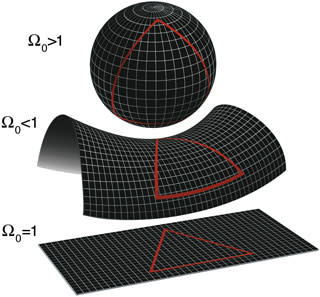Key Takeaways:
- The shape of the universe is a fundamental cosmological question that impacts its past and future.
- The universe can be flat like a sheet of paper, closed like a sphere, or open like a saddle.
- The universe’s fate hinges on its density and rate of expansion.
- A flat universe is the most plausible scenario, with evidence supporting this theory.
- While recent data raised questions about flatness, most scientists maintain that the universe is flat based on overwhelming evidence.
The shape of the universe is a profound cosmological inquiry that holds the key to understanding its past and predicting its future. According to the theory of general relativity, space can take on three potential forms: flat, closed, or open. This celestial geometry is far from trivial; it carries implications for the ultimate destiny of the cosmos.
Princeton University cosmologist David Spergel emphasizes that the universe’s shape reveals crucial insights into its historical evolution and future trajectory. Questions regarding whether the universe will expand indefinitely or eventually contract, as well as its finiteness or infiniteness, all pivot on its shape.
At the heart of this grand inquiry lie two essential factors: the universe’s density and its rate of expansion. Approximately 68 percent of the universe comprises dark energy, with dark matter accounting for 27 percent, leaving a mere fraction for normal matter, which encompasses planets, stars, and celestial bodies. The universe’s density signifies how densely packed its matter is within a given volume of space.

The density dictates the universe’s fate. If gravity overpowers expansion due to high density, the universe would fold into a closed model, exhibiting positive curvature akin to a sphere. Remarkably, this universe would be finite yet boundless; one could journey through it infinitely without encountering boundaries. Conversely, if density is low, unable to halt expansion, the universe would curve in the opposite direction, resulting in an open universe with negative curvature, reminiscent of a saddle.
Scientists argue that the most plausible scenario is a flat universe. The preponderance of cosmological evidence suggests that the universe’s density is finely balanced — approximately six protons per 1.3 cubic yards — and it expands uniformly in all directions, devoid of positive or negative curvature. This depiction aligns with our understanding of a flat geometry in the three-dimensional context.
In order to grasp the concept of a flat universe, one can envision it through analogies. Consider standing in a square room, walking along the walls, and turning at right angles. This action would result in a square. Extending this analogy to three dimensions yields a flat universe. Conversely, a positively curved space indicative of a closed universe would yield a different outcome — it would require an additional turn to return to the starting point.
Another analogy involves two rockets flying alongside each other. In a flat universe, their paths remain parallel, whereas in a closed universe, they would eventually converge due to the curvature of space. In an open universe, their paths would diverge indefinitely.
The cosmic microwave background (CMB), the afterglow of the Big Bang, harbors vital clues about the universe’s shape. Scientists have conducted meticulous measurements of temperature fluctuations in the CMB, effectively performing large-scale trigonometry. The overwhelming consensus is that the universe exhibits minimal curvature, affirming the notion of a flat universe, a cornerstone of the standard cosmological model known as the Lambda cold dark matter (ΛCDM) model.
However, in late 2019, a paper by Alessandro Melchiorri and colleagues suggested that the CMB measurements from the Planck space observatory imply a closed universe. They pointed to an elevated level of gravitational lensing, which deviated from ΛCDM predictions. While this perspective challenges the prevailing notion, most scientists attribute it to a statistical anomaly. The scientific community, bolstered by a wealth of supporting evidence, maintains that the universe is flat.
In a recent paper, David Spergel and fellow researchers merged data from the ACT with the Planck data, affirming the absence of deviation from flatness. Other analyses corroborate this finding, reaffirming the validity of the ΛCDM model. Thus, for the time being, the universe appears to be akin to a three-dimensional sheet of paper.
Nevertheless, given the limits of our observations, there remains a possibility that we are not privy to the full extent of the universe’s curvature. If it is indeed curved, it must be on such a colossal scale that our observable universe constitutes merely a fraction, concealing the curvature’s true magnitude.
In essence, while we assert the universe’s flatness, it’s within the confines of the universe we can perceive, leaving room for intriguing cosmic mysteries beyond our current grasp.


